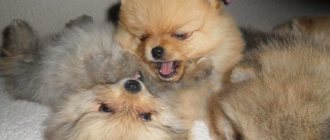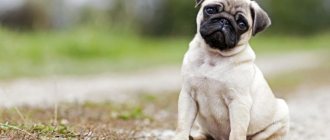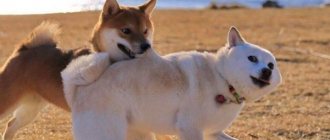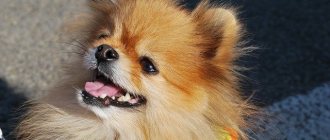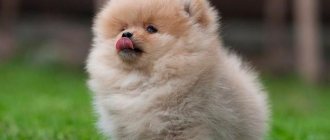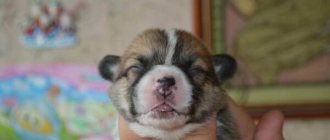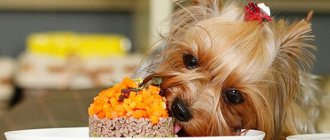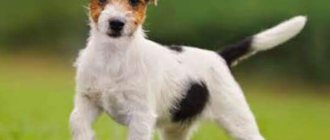Pomeranian puppies are adorable, furry creatures that can often be seen on TV or in photographs.
Small sizes, a touching muzzle and soft, fluffy fur, which makes babies of this breed look like soft toys, cannot but evoke a feeling of delight.
It is not surprising that many people, having only once seen such dogs in a photograph, rushed to get such a cute puppy as soon as possible.
However, before deciding to purchase such a pet, you need to carefully familiarize yourself with the features of choosing a Pomeranian and caring for it.
How many puppies are there in the litter?
Most girls of this breed do not have multiple births, so the average litter size for Pomeranians is 2-3 babies.
The size of the litter largely depends on the size of the bitch.
If the girl is small, weighing approximately 2-2.5 kg, then she will most likely give birth to small or medium-sized litters of puppies.
A larger dog can give birth to 4-6 puppies.
Diseases of the German Spitz
With proper care, the average life expectancy of pets is 14-15 years. They are distinguished by good health, but there are a number of diseases to which German Spitz puppies are susceptible:
- dental pathologies – malocclusion, stone formation on the enamel;
- diseases of the musculoskeletal system - fractures, bruises and subluxations;
- dysfunction of the digestive system - dysbiosis, obesity;
- eye diseases - lacrimation.
Why do my German Spitz's eyes water?
In healthy dogs, minor tearing is allowed. The red German Spitz has a genetic predisposition to the problem. You should consult a doctor if copious amounts of pus are discharged from your eyes. Main causes of the problem:
- ingress of dust and dirt onto mucous membranes;
- allergic reactions;
- serious infectious diseases in the body;
- improperly growing hair around the eyes;
- injury to mucous membranes;
- unbalanced diet.
What do newborns look like and when do they open their eyes?
Newborn Pomeranian puppies don't look much like those fluffy babies in advertising pictures. They are born completely blind and deaf, with a body covered with rather sparse and very short hair.
Babies at this age look disproportionate and not nearly as attractive . Their head is large and slightly flattened, their body is elongated, their legs and tails are relatively short, and their bellies are voluminous.
Pomeranians begin to see the light approximately 10-15 days after they are born..
Muzzle for German Spitz
Finding the right accessory for your pet is not easy. They need to be purchased if the German Spitz is large. For small individuals of the breed in question, a muzzle is not used. The exception is when a mini Spitz throws itself at the feet of others or picks up trash from the floor. In this case, an accessory is ordered for him in individual sizes. Muzzles for Spitz dogs are made from genuine leather or nylon materials.
How it develops from 1 to 12 months
| Puppy age | Description of the stage of growing up | Sizes (medium, for standard size puppies) | Weight (k - dwarf, m - mini, s - standard) |
| 1 month | From about the third week, small Spitz dogs begin to cut their teeth. At this time, puppies behave restlessly, often bark and try to chew everything. Closer to the second month, the main traits of character and temperament are formed. During this time, it is very important that babies interact with other dogs and people. | 7-12 cm | k - 210-275 g m - 325-370 g s - 460-490 g |
| 2 months | The puppy begins to acquire a characteristic appearance: its coat lengthens and becomes fluffier, however, it does not reach the same density and length as in adult dogs. | up to 14 cm | k - 320-460 g m - 550-620 g s - 680-770 g |
| 3 months | The puppy's fur is gradually beginning to be replaced by the adult's, however, at this age the shedding is not yet too noticeable. The babies look like those adorable fluffy puppies from advertising photos. And at this time it is already possible to determine with greater or lesser probability what color they will have. | up to 16 cm | k - 460-690 g m - 800-920 g s - 1.0-1.15 kg |
| 4 months | Little Pomeranians' teeth change and they begin to shed more frequently. Most puppies at this age do not look as attractive as before: almost all of their baby hair has already come out, and their adult hair has not grown back properly. | up to 17 cm | k - 600-880 g m - 1.0-1.175 kg s - 1.3-1.45 kg |
| 5 months | Puppies continue to shed, but by this age some of them already have enough hair to look almost as attractive as when they were young. | up to 18 cm | k - 700-1030 g m - 1.2 - 1.35 kg s - 1.55-1.7 kg |
| 6-9 months | Shedding continues until about 7-9 months, but in some Spitz dogs it is more pronounced, in others less. By 7 months, baby teeth should be replaced by permanent teeth. And at about 7-9 months the first heat occurs in girls of this breed. | 18-20 | k - 770-1150 g m - 1.3-1.5 kg s - 1.7-1.9 kg |
| 12 months | By this age, the Pomeranian will shed again, but its coat will acquire its final appearance and texture by the age of three. | 18-22 | k - 1.0-1.4 kg m - 1.7 - 1.9 kg s - 2.1-2.3 kg |
| Adult | The dog has reached its final physical development and is in the prime of life and beauty. | 18-22 | k - 1.0-1.4 kg m - 1.7 - 1.9 kg s - 2.1-2.3 kg |
Adult Karelian-Finnish Laika
A cute dog, extremely similar to a fox. Laika is an excellent companion and devoted friend of man. Separation from the owner is the worst punishment for a four-legged pet. Their devotion goes to the extreme: they can love only one person all their lives.
The Karelo-Finnish Laika performs well in hunting. Her active character and endurance help to corner the beast. A cheerful disposition will brighten up the life of any person.
The size of an adult Karelian-Finnish husky varies from 42 to 50 cm at the withers. The dog weighs up to 15 kg.
To what age do they grow?
Pomeranians belonging to different lines grow differently: some puppies are fully grown at 4-5 months, while others continue to gain height up to 9 months.
At the same time, in bitches, with the onset of the first emptying, growth may slow down or stop.
On average, Pomeranian puppies grow up to 6 months.
Flaws
According to the standard, the following defects are considered very serious deviations:
- anatomical defects of hereditary origin;
- an apple-shaped head or a skull that is too flat;
- large eye size or lighter shade than usual;
- the nose is lighter than the normal color;
- sharp, loose movements.
Dog show judges may disqualify a Pomeranian if it has the following faults:
- the crown of the Pomeranian Spitz did not grow over in due time;
- snack, undershot;
- eversion or inversion of the eyelids;
- semi-erect ears;
- obvious white spots in all colors except white.
Did you like the article? Is your Pomeranian up to standard?
How to care?
Considering that Spitz fur needs regular combing and sometimes grooming, it is advisable to start accustoming your pet to these procedures as early as possible.
The baby needs to be combed with a wide-toothed comb for 10-15 minutes a day so that he gets used to grooming..
Small puppies should not be bathed too often, and it is very important to dry the coat thoroughly with a hairdryer after washing.
Also, from the very first day, the baby begins to be accustomed to a tray or diaper. To do this, you need to take it there every time after eating or sleeping.
Puppies' nails are trimmed often, as they grow faster than in adult dogs . At the same time, it is very important to carry out this procedure without coercion and, if possible, avoiding accidental injury to the baby.
NOTE!
The teeth of the Pomeranian Spitz require special attention from the owner during their replacement period, since these dogs sometimes have problems due to the baby fangs not falling out in time.
If the owner of the puppy notices that one or more milk teeth have not fallen out, and permanent ones are already growing in their place, then it is necessary to take the pet to the clinic to have them removed.
Daily care should also include eye and ear examinations . This is done not only to find out whether they are dirty, but also to timely detect the first signs of inflammation.
To clean the teeth, you can let your puppy chew on toys purchased at a pet store or special treats..
If plaque forms too quickly and the puppy cannot remove it on his own, then you need to brush his teeth with a dog toothbrush and toothpaste intended for animals.
German Spitz - character traits
Dogs are highly trainable and can get along well with both adults and children, but if left untrained, the pet can become uncontrollable. The Small and German Dwarf Spitz especially love attention, so they always try to be near their owners. Dogs choose one person to whom they are infinitely loyal. He must train the animal.
The positive traits of the breed include patience. Pets tolerate long trips in transport well and can wait for the owner on the side during a walk. Spitz dogs are good with small children, who do not always handle their pets carefully. They get along without problems with other animals in the house because they have a friendly disposition. If necessary, German Spitz dogs come to the defense of the owner and his property, showing all their protective qualities.
What to feed for the first 3 months?
From about the third week, puppies can already begin to be fed solid food . It is most convenient to start complementary feeding with a scraper.
To do this, take a piece of muscle meat and run the edge of a spoon along its side several times. Small balls, slightly larger than a pea, are made from the scraped meat, and one piece is fed to each of the babies.
Some breeders replace scraped meat with minced meat, but this is incorrect, since minced meat is less easily absorbed by the puppy’s body..
Later, babies begin to be introduced to other foods: cottage cheese mixed with kefir or natural yogurt, as well as porridge added to meat and vegetables.
In addition to beef, small Pomeranians can also be fed rabbit meat, turkey or lamb . But it’s too early to give offal at this age.
Then, it will be possible to add boiled sea fish without bones to the diet, and give boiled chicken yolk twice a week.
IMPORTANT!
If you decide to feed the puppies with ready-made food, then this should be done from the very beginning, after the kids try scraped meat for the first time.
In this case, their diet will consist of branded food no lower than super-premium class, which should be soaked in warm water in the first three months of the puppy’s life.
You can also feed puppies wet commercial food that is suitable for their size and age..
How to feed correctly and how often
You need to feed the puppy from a bowl specially designed for this, at a certain time and in the same place.
The pre-measured daily portion should be divided into approximately equal parts according to the number of feedings.
In this case, it is best if the baby eats cottage cheese with kefir or yogurt in the morning, and at all other feedings - meat or fish with porridge and vegetables.
When feeding dry food, it is necessary to measure the portion very carefully, given that Pomeranians eat very little at a time, it is best to use an electronic scale.
The number of feedings depending on the age of the puppy should be as follows:
- 2 months - 5 times a day
- 3-4 months - 4 times a day
- 4-6 months - 3-4 times a day, depending on individual needs
- 6 months - 2-3 times a day.
- 8 months and older - 2 times a day
Dry food should not be mixed with natural products, as this can lead to serious health problems for the dog..
Deviations or norm
Each dog has individual characteristics, so do not panic if your pet develops a little faster or slower than prescribed by the standards.
Several factors influence the growth and development of a Spitz:
- Genetics. If your pet's body weight deviates from the standards, pay attention to the pedigree. Perhaps your pet's mom or dad had greater height and weight than indicated in the breed standards.
- Diet. If your baby eats only natural food, he will gain weight by six months. On dry food, even premium-class Spitz dogs gain weight more slowly.
- Vitamins. The lack of vitamins in a dog’s body, like diet, affects the development of its skeleton.
- Activity. Long walks with physical activity contribute to the formation of a large muscle corset. A puppy that runs a lot will be larger and more athletic than one that leads a moderate lifestyle.
First vaccinations
The first vaccinations are given at approximately 2 months. By this time, the immunity received by the puppy from its mother’s milk is already beginning to weaken, and therefore, if the babies are not vaccinated in time, they will catch literally every infection.
As a rule, puppies, and even adult dogs, are given complex vaccines that protect them from several diseases at once..
Such diseases include leptospirosis, hepatitis, distemper, parainfluenza and enteritis - that is, the most dangerous infections for animals, which, even with early treatment, often end in the death of the pet.
CAREFULLY!
They are especially dangerous for puppies, and therefore it is very important to strictly follow the vaccination schedule suggested by your veterinarian.
Usually, the first vaccine is given at 8-9 weeks . Two weeks after it comes revaccination, which should not be skipped under any circumstances. After this, the dog is vaccinated at 6 and 12 months.
Starting at 12 weeks, the puppy will also need to be vaccinated against rabies..
German Spitz training
Thanks to their keen mind, representatives of the breed in question can easily carry out all the commands of the owner. The breeder must wean the dog from barking loudly for no reason and begging for food. Without training, your German Spitz puppy will become capricious and uncontrollable. Another important point in raising a pet is training it to use the tray. Before buying a puppy, you need to ask the seller what he is accustomed to: newspaper, diaper or outdoors. At first, you need to organize the same toilet for the animal.
Training begins at 5 months of age. First, Spitz dogs are taught to respond to a name. Another important command that a dog must know is place. To do this, after feeding, the puppy is taken to the mat and this word is said. Next, the Spitz is taught other necessary commands: to me, next to me. They are needed to keep your pet safe. The last command that the dog must be taught is fu.
How to choose?
When purchasing a pet, you need to treat it as responsibly as possible: study the basic requirements of the standard, conditions of keeping and feeding.
Also, even before purchasing a puppy, you need to purchase what you will need to care for it: toys, shampoos, a bed, a bowl, a tray, etc..
In order to avoid unpleasant surprises associated with purchasing a mongrel puppy instead of a Pomeranian or problems with the pet’s health, it is recommended to contact a club or kennel.
At the same time, you need to formulate your wishes regarding the puppy as precisely as possible: you need a show dog or a dog for breeding, or maybe just a pet.
Based on this, the breeder will be able to select the most suitable puppy for the buyer..
Before buying a baby, the future owner needs to check whether its exterior meets the breed standard, and also make sure that the puppy is healthy.
A small Pomeranian should have a compact, almost square body, strong, thick paws, a muzzle that is not too long, but not too short, and a fairly convex skull..
His back is not sagging, and his stomach is only moderately retracted. In this case, the puppy should look quite dense and well-fed, with clean eyes, ears and skin.
The color of the baby may differ from the color of the coat that he will have after growing up.
For example, red dogs are born brown and only gradually acquire an orange tint to their coat.
However, black , white and brown Pomeranians should look as uniform in color as possible, since even the slightest extraneous tint is not allowed in these colors .
German Spitz - description of the breed
There are several types of such pets:
The listed types differ in size. The small German Spitz grows up to 29 cm, the dwarf Spitz - up to 22 cm. Other characteristics are similar for all varieties. The dogs have a square body and a large fluffy tail that fits tightly to the back. The Spitz has a medium-sized head, and the muzzle tapers towards the nose. Its lobe is colored brown or black.
The German Spitz breed has a double undercoat. The shortest hair is on the ears and face. Standard colors of the breed: gray, white, brown, tan. The fur color of animals can change during puppyhood, but by the age of three it acquires permanent shades. The German Spitz is also called the Pomeranian. However, in the USA, Canada and England these breeds are considered different.
What does a German Spitz look like?
The breed must meet a number of standards. This does not depend on what kind of dog you are considering - red, black or white German Spitz. Main external characteristics:
- head – wedge-shaped;
- nose - round, dark in color;
- bite – pincer-shaped with 42 teeth;
- eyes – almond-shaped, medium size;
- neck – moderately long, has a bend at the nape;
- ears – closely spaced triangular;
- tail - in the form of a single ring;
- legs are muscular, straight.
